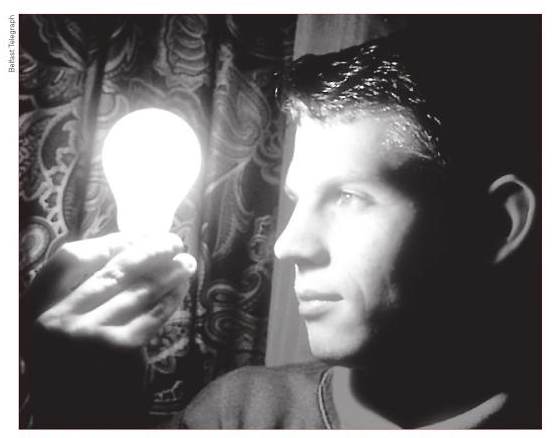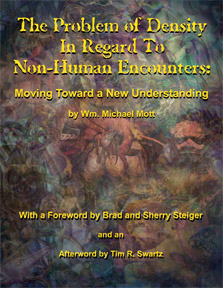- GOING FERAL DEPARTMENT -
“Wild Men” May Be Lurking in North America’s Remote Woodlands
By Micah Hanks

“I thought it was a feral
human,” Mike Wooley recalls of the incident,
arguably the strangest to occur during his
time as an outdoorsmen. “I had heard about
them, and done some reading about them.”
Recalling the events of that December day in
1981, Wooley soberly tells of something
frightening that occurred in the Louisiana
backwoods that changed his life.
“It was a beautiful day, a perfect day for a hunt.” Wooley arrived at his deer stand, located down an old logging road in an area he had hunted frequently, and parking his vehicle halfway down the road, he walked to his tree stand, climbed into it, and silently enjoyed the cool air of the day while waiting for signs of game in the area.
After some time, the sound of an animal crashing through the brush caught his attention. Accompanying the sounds had been a small doe, which darted directly toward his stand and nestled beneath it, breathless. Wooley initially thought the tired deer had been chased by a larger potential mate, and waited eagerly for the buck to appear so it could be claimed.
What appeared instead defied every concept of what “should” exist here in Louisiana, or anywhere else.
A tremendous humanoid, covered in short hair, appeared instead, headed directly toward the deer, and Wooley’s tree stand, seemingly unaware of the hunter resting in it above. The figure approached to just a short distance of twenty yards before it stopped and, becoming alert to Wooley’s presence, peered up at him, its face wrenching angrily.
“As far as a Bigfoot, I thought that was something that (only) existed out in California. I thought that was something somebody made up to make money off of.” Contrary to his previous feelings, Wooley watched the thing for several frightened moments, eventually raising his hunting rifle and observing the thing’s face through the scope, though afraid to shoot anything that looked so human.
“The face was too human. The eyelashes, the teeth, the jaw structure, the forehead. The face was light brown, like it had a dark sun tan. But I couldn’t pull the trigger, because something told me this ain’t right. It’s not the right thing to do.”
The thing growled at Wooley in a way that reminded him of a lion’s roar, to which a loud whistle echoed from someplace up the ridge, as though in response. The “wild man” became alert to this, and appeared to respond with a similar whistle, then looked back at Wooley, who by now had chosen to take action. Leaping from the tree stand, he took off up the wagon road, attempting to close the short distance between his truck, and the location where this strange and feral intruder had now begun to pursue him.
Wooley made it to his truck, and turning to fire a warning shot, watched as the wood on a nearby tree splintered only feet away from the approaching man-beast. He then entered his truck and left, watching behind him as a second humanoid emerged from the brush, which joined his initial pursuer to watch him as he sped away from terrifying experience.
If anything, Wooley is lucky to have survived this alleged encounter with something that, if not human, had been remarkably close, but still different enough to arouse confusion about what he had seen, and whether killing it in self-defense would be ethical, or even lawful. Wooley hadn’t been quick to accept the idea of a Bigfoot standing before him, and despite thinking it could have been someone in a costume, had initially questioned whether some kind of “feral human” might have stood before him, upon observing the details of it’s face through the scope on his rifle.
While the idea of Bigfoot–a large, hairy manlike beast purported to exist in the North American wilds–is and has been a popular cultural phenom for the last half century or more, less often is the issue of actual feral humans discussed in relation to supposed Bigfoot encounters. Science does not accept the existence of such creatures as a reality (yet, at least). But on the subject of feral humans existing in remote areas, there may indeed be some compelling, if not frightening supporting data.
In what led to the authorship of the Missing 411 book series, author and retired law enforcement officer David Paulides had begun researching strange disappearances in National Parks (which, it should be noted, he does not view in direct correlation with things like Bigfoot reports, instead taking a more objective, statistical approach to his investigations). However, one of the most compelling cases Paulides began to study early on had been the disappearance of a young boy, Dennis Martin, who vanished from within sight of his father in the summer of 1969 near Cades Cove in the Great Smoky Mountains National Park.
One of the most striking details of the case (and one which National Park Service documents pertaining to Martin’s disappearance failed to note) had involved a strange observation made shortly after Dennis Martin went missing, a short distance away near the area of Rowans Creek. Mr. Harold Key and his family had been walking a trail in the area looking for wildlife–in particular, any sign of black bears nearby–when they heard “an enormous, sickening scream.” Within moments, Key’s son pointed out a bear nearby, located up the ridge from them. Mr. Key, upon observing the “bear” his son had spotted, determined this to be not a bear, but a “dark figured, rough-looking man” attempting to remain concealed behind a thicket.
The man, which Key didn’t manage to view in clear detail, had purportedly been carrying something over his shoulder; Harold Key, unaware of Dennis Martin’s disappearance earlier that afternoon, supposed that the figure might have been a moonshiner who had trying to hide from them. Upon learning days later of the search for Dennis Martin, Harold Key notified the FBI about what he and his family had seen the same afternoon Dennis went missing.
Dennis Martin was never found, although the footprint of a small boy’s Oxford-style shoe was located a few days after he vanished, and within 3.5 miles of Spence Field, where the Martin family had camped the night before. Several years afterward, an illegal ginseng hunter would come forward, claiming he had found the skull and other remains of a small boy in the same vicinity; however, a search of the area yielded no results so many years after the fact, as the man had feared that he might be arrested for his illegal activity in the area that led him to the discovery.
Still, along with the Oxford print by the nearby Pigeon River, the case of the “rough looking man” had been the other in a pair of leads later cited by retired National Park Ranger Dwight McCarter, which he had wished had been more carefully examined. During meeting between Paulides and McCarter in 2011, the retired Ranger had discussed “wild men” that were known to have lived in the area at the time of the Martin disappearance; however, these were not any sort of “wild creature” apart from mere humans which had made a conscious choice to live off the land. One of these individuals, according to McCarter, had even “worn a bear skin” around his person while trudging through the forest. Is there any connection that could be made between a wild or feral human in the Great Smoky Mountains National Forest, and the disappearance of Dennis Martin?
It should be noted, however, that the purported location of the child’s remains that were observed by the ginseng hunter had been three miles from Spence Field, and in the same direction of the shoe print searchers found by the Pigeon River; the location where Harold Key and his family heard the chilling scream just prior to observing a “rough looking man”, possibly carrying something on his shoulder, had been nine miles from the location. Unfortunately, due to the circumstances of the testimony provided by the ginseng poacher, no success came with subsequent searches for the mystery child’s remains, and thus no hard proof that a body was indeed found in that area can be offered.
The idea of “feral” wild men living off foraging and, at times, theft from hikers and campers in wilderness areas is more common than many would think. In 2013, Caity Weaver wrote an article on this with the rather sensational headline, “Feral, Thieving Mountain Men Keep Emerging from America’s Woods, Unwillingly.” In it, she discussed a pair of arrests of men who had been operating very similar to Dwight McCarter’s mention of “Wild Men” in the Smoky Mountains:
Early last week, authorities in Utah arrested Troy Knapp, the notorious “Mountain Man” outlaw, who had been robbing and defacing cabins in the southern portion of the state for nearly a decade. Two days later, officers from the Maine Warden Service arrested a legend known to locals as “the backpack burglar,” who had been living alone deep in the woods of Central Maine, burglarizing camps for 27 years.
The latter of these men had existed (unlawfully, mind you) for nearly three decades in Central Maine, an area which,in terms of climate, might present far greater perils than the locations of Wooley’s encounter with a beastly “feral human,” or even that of the Great Smoky Mountains National Park along the borders on North Carolina and Tennessee. Weaver went on to note of Christopher Knight, Maine’s mystery wild-man, that
Officers reported that Knight was clean-shaven, wearing a pair of clean jeans and a clean shirt. (His campsite included a makeshift shower protected by firs.) He told police he had spoken to only one other human since 1986: a hiker he encountered on a trail in the mid-1990s with whom he’d exchanged a brief hello… Knight, who offered no explanation as to why he decided to live alone in the woods for 27 years (“He said he frequently asks himself that same question,” said a Maine State Trooper), expressed “shame and remorse” over his burglaries and added that he was relieved to longer be living in solitude. He’s currently in jail on charges of burglary and theft.
Knight obviously didn’t fit the description many would stereotypically append to a purported “feral human” or “wild man,” unlike the mystery man clad in a bear’s skin that Dwight McCarter described to David Paulides. Still, it is interesting to consider the things that might drive a person to live in solitude like this for so long, and of course, the lengths to which they would go to survive. Obviously, theft is a common attribute… and depending on the individual, how much more would it take for the abduction of a small child to take place? Park Rangers had noted that food supplies for creatures like bears had been extremely low in the summer of 1969, with one unhealthy and emaciated bear reportedly released from capture near a feeding plot for deer. Arguably, anything living in the area would have faced the strains of this kind of food shortage; whether or not the culprit had been a bear or not is irrelevant.
To suppose instances of “wild” or feral humans living in remote areas is not intended to undermine the possibility that a creature like Bigfoot might exist. Nor is it offered here as an alternative explanation for things seen by the likes of Mike Wooley and other outdoorsmen who claim having encounters with man-like beasts.
But even for men who seek such monsters, it is hard to deny that in many cases, the most frightening beasts available to the mind are those which walk on two legs; no question over the existence of a Bigfoot is needed just to see the concern this statement entails, and the grim possibilities regarding strange disappearances of people from our National Parks it might suggest.
Source: Mysterious Universe
http://mysteriousuniverse.org/2014/05/wild-men-and-feral-hermits-may-be-lurking-in-north-americas-remote-woodlands/
“It was a beautiful day, a perfect day for a hunt.” Wooley arrived at his deer stand, located down an old logging road in an area he had hunted frequently, and parking his vehicle halfway down the road, he walked to his tree stand, climbed into it, and silently enjoyed the cool air of the day while waiting for signs of game in the area.
After some time, the sound of an animal crashing through the brush caught his attention. Accompanying the sounds had been a small doe, which darted directly toward his stand and nestled beneath it, breathless. Wooley initially thought the tired deer had been chased by a larger potential mate, and waited eagerly for the buck to appear so it could be claimed.
What appeared instead defied every concept of what “should” exist here in Louisiana, or anywhere else.
A tremendous humanoid, covered in short hair, appeared instead, headed directly toward the deer, and Wooley’s tree stand, seemingly unaware of the hunter resting in it above. The figure approached to just a short distance of twenty yards before it stopped and, becoming alert to Wooley’s presence, peered up at him, its face wrenching angrily.
“As far as a Bigfoot, I thought that was something that (only) existed out in California. I thought that was something somebody made up to make money off of.” Contrary to his previous feelings, Wooley watched the thing for several frightened moments, eventually raising his hunting rifle and observing the thing’s face through the scope, though afraid to shoot anything that looked so human.
“The face was too human. The eyelashes, the teeth, the jaw structure, the forehead. The face was light brown, like it had a dark sun tan. But I couldn’t pull the trigger, because something told me this ain’t right. It’s not the right thing to do.”
The thing growled at Wooley in a way that reminded him of a lion’s roar, to which a loud whistle echoed from someplace up the ridge, as though in response. The “wild man” became alert to this, and appeared to respond with a similar whistle, then looked back at Wooley, who by now had chosen to take action. Leaping from the tree stand, he took off up the wagon road, attempting to close the short distance between his truck, and the location where this strange and feral intruder had now begun to pursue him.
Wooley made it to his truck, and turning to fire a warning shot, watched as the wood on a nearby tree splintered only feet away from the approaching man-beast. He then entered his truck and left, watching behind him as a second humanoid emerged from the brush, which joined his initial pursuer to watch him as he sped away from terrifying experience.
If anything, Wooley is lucky to have survived this alleged encounter with something that, if not human, had been remarkably close, but still different enough to arouse confusion about what he had seen, and whether killing it in self-defense would be ethical, or even lawful. Wooley hadn’t been quick to accept the idea of a Bigfoot standing before him, and despite thinking it could have been someone in a costume, had initially questioned whether some kind of “feral human” might have stood before him, upon observing the details of it’s face through the scope on his rifle.
While the idea of Bigfoot–a large, hairy manlike beast purported to exist in the North American wilds–is and has been a popular cultural phenom for the last half century or more, less often is the issue of actual feral humans discussed in relation to supposed Bigfoot encounters. Science does not accept the existence of such creatures as a reality (yet, at least). But on the subject of feral humans existing in remote areas, there may indeed be some compelling, if not frightening supporting data.
In what led to the authorship of the Missing 411 book series, author and retired law enforcement officer David Paulides had begun researching strange disappearances in National Parks (which, it should be noted, he does not view in direct correlation with things like Bigfoot reports, instead taking a more objective, statistical approach to his investigations). However, one of the most compelling cases Paulides began to study early on had been the disappearance of a young boy, Dennis Martin, who vanished from within sight of his father in the summer of 1969 near Cades Cove in the Great Smoky Mountains National Park.
One of the most striking details of the case (and one which National Park Service documents pertaining to Martin’s disappearance failed to note) had involved a strange observation made shortly after Dennis Martin went missing, a short distance away near the area of Rowans Creek. Mr. Harold Key and his family had been walking a trail in the area looking for wildlife–in particular, any sign of black bears nearby–when they heard “an enormous, sickening scream.” Within moments, Key’s son pointed out a bear nearby, located up the ridge from them. Mr. Key, upon observing the “bear” his son had spotted, determined this to be not a bear, but a “dark figured, rough-looking man” attempting to remain concealed behind a thicket.
The man, which Key didn’t manage to view in clear detail, had purportedly been carrying something over his shoulder; Harold Key, unaware of Dennis Martin’s disappearance earlier that afternoon, supposed that the figure might have been a moonshiner who had trying to hide from them. Upon learning days later of the search for Dennis Martin, Harold Key notified the FBI about what he and his family had seen the same afternoon Dennis went missing.
Dennis Martin was never found, although the footprint of a small boy’s Oxford-style shoe was located a few days after he vanished, and within 3.5 miles of Spence Field, where the Martin family had camped the night before. Several years afterward, an illegal ginseng hunter would come forward, claiming he had found the skull and other remains of a small boy in the same vicinity; however, a search of the area yielded no results so many years after the fact, as the man had feared that he might be arrested for his illegal activity in the area that led him to the discovery.
Still, along with the Oxford print by the nearby Pigeon River, the case of the “rough looking man” had been the other in a pair of leads later cited by retired National Park Ranger Dwight McCarter, which he had wished had been more carefully examined. During meeting between Paulides and McCarter in 2011, the retired Ranger had discussed “wild men” that were known to have lived in the area at the time of the Martin disappearance; however, these were not any sort of “wild creature” apart from mere humans which had made a conscious choice to live off the land. One of these individuals, according to McCarter, had even “worn a bear skin” around his person while trudging through the forest. Is there any connection that could be made between a wild or feral human in the Great Smoky Mountains National Forest, and the disappearance of Dennis Martin?
It should be noted, however, that the purported location of the child’s remains that were observed by the ginseng hunter had been three miles from Spence Field, and in the same direction of the shoe print searchers found by the Pigeon River; the location where Harold Key and his family heard the chilling scream just prior to observing a “rough looking man”, possibly carrying something on his shoulder, had been nine miles from the location. Unfortunately, due to the circumstances of the testimony provided by the ginseng poacher, no success came with subsequent searches for the mystery child’s remains, and thus no hard proof that a body was indeed found in that area can be offered.
The idea of “feral” wild men living off foraging and, at times, theft from hikers and campers in wilderness areas is more common than many would think. In 2013, Caity Weaver wrote an article on this with the rather sensational headline, “Feral, Thieving Mountain Men Keep Emerging from America’s Woods, Unwillingly.” In it, she discussed a pair of arrests of men who had been operating very similar to Dwight McCarter’s mention of “Wild Men” in the Smoky Mountains:
Early last week, authorities in Utah arrested Troy Knapp, the notorious “Mountain Man” outlaw, who had been robbing and defacing cabins in the southern portion of the state for nearly a decade. Two days later, officers from the Maine Warden Service arrested a legend known to locals as “the backpack burglar,” who had been living alone deep in the woods of Central Maine, burglarizing camps for 27 years.
The latter of these men had existed (unlawfully, mind you) for nearly three decades in Central Maine, an area which,in terms of climate, might present far greater perils than the locations of Wooley’s encounter with a beastly “feral human,” or even that of the Great Smoky Mountains National Park along the borders on North Carolina and Tennessee. Weaver went on to note of Christopher Knight, Maine’s mystery wild-man, that
Officers reported that Knight was clean-shaven, wearing a pair of clean jeans and a clean shirt. (His campsite included a makeshift shower protected by firs.) He told police he had spoken to only one other human since 1986: a hiker he encountered on a trail in the mid-1990s with whom he’d exchanged a brief hello… Knight, who offered no explanation as to why he decided to live alone in the woods for 27 years (“He said he frequently asks himself that same question,” said a Maine State Trooper), expressed “shame and remorse” over his burglaries and added that he was relieved to longer be living in solitude. He’s currently in jail on charges of burglary and theft.
Knight obviously didn’t fit the description many would stereotypically append to a purported “feral human” or “wild man,” unlike the mystery man clad in a bear’s skin that Dwight McCarter described to David Paulides. Still, it is interesting to consider the things that might drive a person to live in solitude like this for so long, and of course, the lengths to which they would go to survive. Obviously, theft is a common attribute… and depending on the individual, how much more would it take for the abduction of a small child to take place? Park Rangers had noted that food supplies for creatures like bears had been extremely low in the summer of 1969, with one unhealthy and emaciated bear reportedly released from capture near a feeding plot for deer. Arguably, anything living in the area would have faced the strains of this kind of food shortage; whether or not the culprit had been a bear or not is irrelevant.
To suppose instances of “wild” or feral humans living in remote areas is not intended to undermine the possibility that a creature like Bigfoot might exist. Nor is it offered here as an alternative explanation for things seen by the likes of Mike Wooley and other outdoorsmen who claim having encounters with man-like beasts.
But even for men who seek such monsters, it is hard to deny that in many cases, the most frightening beasts available to the mind are those which walk on two legs; no question over the existence of a Bigfoot is needed just to see the concern this statement entails, and the grim possibilities regarding strange disappearances of people from our National Parks it might suggest.
Source: Mysterious Universe
http://mysteriousuniverse.org/2014/05/wild-men-and-feral-hermits-may-be-lurking-in-north-americas-remote-woodlands/
- SEND IN THE
FANTASTIC FIVE DEPARTMENT -
Beware the "Bermuda Triangle of Space"
Beware the "Bermuda Triangle of Space"

It is known as the 'Bermuda triangle of space' and is one of the most dangerous areas of radiation ever encountered.
European researchers today revealed a glimpse into the bizarre radiation zone a few hundred kilometres above the coast of Brazil.
Known as the South Atlantic Anomaly (SAA), it is the point where the Van Allen radiation belts – rings of charged particles that surround Earth – come closest to the planet's surface.
When the belts were discovered in the 1950s, scientists suspected the SAA could pose some risk.
Astronauts' on the space shuttle complained laptop computers would sometimes crash when they passed through the anomaly.
Some spacecraft, such as the Hubble Space Telescope, are even programmed to switch off their delicate instruments as they fly through the area to avoid damage.
The International Space Station has also been given extra shielding to deal with this problem.
Astronauts are also affected by this region, which is said to be the cause of peculiar 'shooting stars' (phosphenes) seen in the visual field of astronauts.
Passing through the South Atlantic Anomaly is also thought to be the reason for the early failures of the Globalstar network's satellites.
Riccardo Campana at the National Institute for Astrophysics in Bologna, Italy, has analysed radiation data from an X-ray-monitoring satellite called BeppoSAX, which was active from 1996 to 2003.
They found that radiation levels in the lower layer of the SAA were much less than in the upper layers.
They also saw that the anomaly is slowly moving westwards.
The team is now designing a space telescope that will orbit through the lower part of the danger zone, which is not well studied.
'Most radiation models used in planning space missions are based on extrapolations from high-latitude, high-inclination observations,' Campana told New Scientist.
'Low-inclination, low altitude Earth orbits (LEO) are of increasing importance for astrophysical satellites, due to their low background environment, the team wrote.
'We study the radiation environment in a LEO (500-600 km altitude, 4 degrees inclination) through the particle background measured by the Particle Monitor (PM) experiment onboard the BeppoSAX satellite, between 1996 and 2002.
'The low-latitude SAA regions are found to have an intensity strongly decreasing with altitude and dependent on the magnetic rigidity. The SAA extent, westward drift and strength vs altitude is shown.'
Source: The Daily Mail
http://www.dailymail.co.uk/sciencetech/article-2640056/Strange-flashing-lights-radiation-risks-The-bermuda-triangle-space-revealed-unprecedented-detail.html
-
HOWLING AT THE MOON ON A HOT SUMMER NIGHT
DEPARTMENT -
Full Moon Link to Animal Behavior Revealed
Full Moon Link to Animal Behavior Revealed

According to the latest research, it's not
werewolves running amok
during full moons—it’s cats and dogs. The
new study suggests that pets
get into more mischief and are injured more
often during certain phases
of the lunar cycle, particularly when the
moon is fullest.
The study, authored by Raegan Wells, DVM, and her colleagues at Colorado State University's College of Veterinary Medicine and Biomedical Sciences, revealed a link between an increase in emergency room visits for dogs and cats during days when the moon is at or near its fullest.
Wells said this is the first time the lunar cycle's relationship to emergency veterinary medicine has been studied. The study, titled "Canine and feline emergency room visits and the lunar cycle,” appears in the Journal of the American Veterinary Medical Association.
The data, compiled from case histories of 11,940 dogs and cats treated at the university's Veterinary Medical Center, indicates that the risk of emergencies on fuller moon days was 23 percent greater in cats and 28 percent greater in dogs when compared with other days. The types of emergencies ranged from cardiac arrest to epileptic seizures and trauma, and the increase was most pronounced during the moon's three fullest stages—waxing gibbous, full and waning gibbous.
"If you talk to any person, from kennel help, nurse, front-desk person to doctor, you frequently hear the comment on a busy night, 'Gee is it a full moon?'" said Wells. "There is the belief that things are busier on full-moon nights."
Of course, superstition alone does not make for good science, but this research indicates that long held belief may be based in fact. But despite the baffling results, Wells doesn't know what sort of connection is at play here.
Modern studies have associated the full Moon with insanity, traffic accidents, increased aggression, unintentional poisonings and absenteeism, and the female menstrual cycle, but many of the connections are thin and vary widely from study to study.
"While the results of our retrospective study indicate that there is an increased likelihood of emergency room visits on the days surrounding a full moon, it is difficult to interpret the clinical significance of these findings," Wells writes.
Historically there has been a widespread belief that a full moon can effect people and animals causing them to act strangely. In fact, the word ‘Lunatic’ came about due to the belief that the Moon can make one mad.
But just what is behind the pet emergency and full moon correlation, however, is not at all clear. One theory is that since there’s more light out, people and their pets may be more likely to be out getting into mischief. So, what does all this mean for pet owners?
"It serves as a good reminder to remain cognizant of your pet's environment and overall health status, and to avoid situations that would put them in harm's way," Wells said.
This advice includes keeping a closer eye on them near the full moon, when their likelihood of injury explicable peaks.
Source: The Daily Galaxy
http://www.dailygalaxy.com/my_weblog/2007/08/does-a-full-moo.html
- OUT OF THIN AIR DEPARTMENT -
The Power to Materialize Things

The study, authored by Raegan Wells, DVM, and her colleagues at Colorado State University's College of Veterinary Medicine and Biomedical Sciences, revealed a link between an increase in emergency room visits for dogs and cats during days when the moon is at or near its fullest.
Wells said this is the first time the lunar cycle's relationship to emergency veterinary medicine has been studied. The study, titled "Canine and feline emergency room visits and the lunar cycle,” appears in the Journal of the American Veterinary Medical Association.
The data, compiled from case histories of 11,940 dogs and cats treated at the university's Veterinary Medical Center, indicates that the risk of emergencies on fuller moon days was 23 percent greater in cats and 28 percent greater in dogs when compared with other days. The types of emergencies ranged from cardiac arrest to epileptic seizures and trauma, and the increase was most pronounced during the moon's three fullest stages—waxing gibbous, full and waning gibbous.
"If you talk to any person, from kennel help, nurse, front-desk person to doctor, you frequently hear the comment on a busy night, 'Gee is it a full moon?'" said Wells. "There is the belief that things are busier on full-moon nights."
Of course, superstition alone does not make for good science, but this research indicates that long held belief may be based in fact. But despite the baffling results, Wells doesn't know what sort of connection is at play here.
Modern studies have associated the full Moon with insanity, traffic accidents, increased aggression, unintentional poisonings and absenteeism, and the female menstrual cycle, but many of the connections are thin and vary widely from study to study.
"While the results of our retrospective study indicate that there is an increased likelihood of emergency room visits on the days surrounding a full moon, it is difficult to interpret the clinical significance of these findings," Wells writes.
Historically there has been a widespread belief that a full moon can effect people and animals causing them to act strangely. In fact, the word ‘Lunatic’ came about due to the belief that the Moon can make one mad.
But just what is behind the pet emergency and full moon correlation, however, is not at all clear. One theory is that since there’s more light out, people and their pets may be more likely to be out getting into mischief. So, what does all this mean for pet owners?
"It serves as a good reminder to remain cognizant of your pet's environment and overall health status, and to avoid situations that would put them in harm's way," Wells said.
This advice includes keeping a closer eye on them near the full moon, when their likelihood of injury explicable peaks.
Source: The Daily Galaxy
http://www.dailygalaxy.com/my_weblog/2007/08/does-a-full-moo.html
- OUT OF THIN AIR DEPARTMENT -
The Power to Materialize Things

The
Christian Bible has a story
about Jesus Christ feeding 5,000 people
with a few pieces of bread and
fish. Not only did they have their fill,
but several baskets of
leftovers were collected.
This act is considered a miracle in Christianity. Today, the science of parapsychology calls it “materialization,” “producing something out of nothing.”
Stage magicians and illusionists, like the world-renowned David Copperfield, can make birds appear out of nowhere and even make a live elephant disappear in front of a large crowd. But they do these by sleight-of-hand, illusion or trickery.
I have personally seen cases of materialization that are not products of illusion or trickery. One involved Sri Lankan spiritual guru Swami Premananda. He just moves his hand, palm down, in the air. When he turns his palm up, a statue of a Hindu god, or crucifix or anything suddenly appears on it.
He has done this countless of times before various audiences. I’ve also seen video tapes of more spectacular materializations performed by the Indian guru Swami Satya Sai Baba.
Strict scientific observations have been done by western investigators on these two spiritual teachers with extraordinary psychic powers. No one has ever proved that any one of them is performing trickery. They were genuine materializations.
Our world-famous Filipino faith healers and psychic surgeons are also able to materialize things. But what they materialize are diseased tissues or flesh and blood, not birds or elephants. They also materialize objects inserted into victims’ bodies through sorcery or black magic, such as broken glass, cockroaches, nails, egg shells, hair, plastic ropes, etc.
How is materialization done? There are different ways of doing this. One is through sheer mental power.
A person must be able to visualize in very clear and vivid detail the object he wishes to materialize. He must be able to see, feel, taste, smell and hear the object. He must also have a strong desire or intention to make that object appear physically in front of him. And he must be able to slow down his brain waves to the Delta level (almost zero to four cycles per second) without falling asleep. These are the conditions for materialization to take place.
In the late ’80s, I observed a poor man named Estong materialize coins from his mouth on the streets of Edsa Central in Mandaluyong City. Bus and jeepney drivers would give him, for example, 25-centavo coins. He would put the coin in his empty mouth and when he opened it, a one-peso coin had replaced the 25-centavo coin.
Others are able to materialize things with the help of some spirit helpers or guides and not just through their mental powers. These people are able to get such spirits to do their bidding.
Materialization need not be immediate or instantaneous, like what Swami Premananda or Swami Sai Baba does. It can be over a period of time. But the result is the same eventually, namely, the sudden physical appearance of something desired.
For example, a housewife one afternoon wanted to eat a banana but it was not being sold nearby. After a while, that same afternoon, somebody knocked on her door, a banana vendor. He said it was not his usual route. Isn’t this a case of materialization, too?
There are many examples of this type of materialization in daily life. A boy wishing to have a particular toy receives it as a gift, although he told no one about it. A lowly employee wanting to own an expensive camera he couldn’t afford suddenly gets one from a cousin who unexpectedly arrives from Saudi Arabia.
A regular reader of this column sent me recently a text message saying, on many occasions, what she had in mind would just come to her or would be offered to her without her telling anybody about it.
If one argues that only God can make miracles, like making things appear out of nowhere, tell him that Jesus Christ himself said in the Bible: (John 14:12) “All the works that I have done you can do, and much more than these.”
Source: Philippine Daily Inquirer
http://showbizandstyle.inq7.net/lifestyle/lifestyle/view_article.php?article_id=16505
Sign
up today for Bizarre Bazaar and Conspiracy
Journal MagazinesThis act is considered a miracle in Christianity. Today, the science of parapsychology calls it “materialization,” “producing something out of nothing.”
Stage magicians and illusionists, like the world-renowned David Copperfield, can make birds appear out of nowhere and even make a live elephant disappear in front of a large crowd. But they do these by sleight-of-hand, illusion or trickery.
I have personally seen cases of materialization that are not products of illusion or trickery. One involved Sri Lankan spiritual guru Swami Premananda. He just moves his hand, palm down, in the air. When he turns his palm up, a statue of a Hindu god, or crucifix or anything suddenly appears on it.
He has done this countless of times before various audiences. I’ve also seen video tapes of more spectacular materializations performed by the Indian guru Swami Satya Sai Baba.
Strict scientific observations have been done by western investigators on these two spiritual teachers with extraordinary psychic powers. No one has ever proved that any one of them is performing trickery. They were genuine materializations.
Our world-famous Filipino faith healers and psychic surgeons are also able to materialize things. But what they materialize are diseased tissues or flesh and blood, not birds or elephants. They also materialize objects inserted into victims’ bodies through sorcery or black magic, such as broken glass, cockroaches, nails, egg shells, hair, plastic ropes, etc.
How is materialization done? There are different ways of doing this. One is through sheer mental power.
A person must be able to visualize in very clear and vivid detail the object he wishes to materialize. He must be able to see, feel, taste, smell and hear the object. He must also have a strong desire or intention to make that object appear physically in front of him. And he must be able to slow down his brain waves to the Delta level (almost zero to four cycles per second) without falling asleep. These are the conditions for materialization to take place.
In the late ’80s, I observed a poor man named Estong materialize coins from his mouth on the streets of Edsa Central in Mandaluyong City. Bus and jeepney drivers would give him, for example, 25-centavo coins. He would put the coin in his empty mouth and when he opened it, a one-peso coin had replaced the 25-centavo coin.
Others are able to materialize things with the help of some spirit helpers or guides and not just through their mental powers. These people are able to get such spirits to do their bidding.
Materialization need not be immediate or instantaneous, like what Swami Premananda or Swami Sai Baba does. It can be over a period of time. But the result is the same eventually, namely, the sudden physical appearance of something desired.
For example, a housewife one afternoon wanted to eat a banana but it was not being sold nearby. After a while, that same afternoon, somebody knocked on her door, a banana vendor. He said it was not his usual route. Isn’t this a case of materialization, too?
There are many examples of this type of materialization in daily life. A boy wishing to have a particular toy receives it as a gift, although he told no one about it. A lowly employee wanting to own an expensive camera he couldn’t afford suddenly gets one from a cousin who unexpectedly arrives from Saudi Arabia.
A regular reader of this column sent me recently a text message saying, on many occasions, what she had in mind would just come to her or would be offered to her without her telling anybody about it.
If one argues that only God can make miracles, like making things appear out of nowhere, tell him that Jesus Christ himself said in the Bible: (John 14:12) “All the works that I have done you can do, and much more than these.”
Source: Philippine Daily Inquirer
http://showbizandstyle.inq7.net/lifestyle/lifestyle/view_article.php?article_id=16505
















